It’s a barge! It’s a boat! It’s the J Barry Ferguson
author Cimino
published 28 June 2023
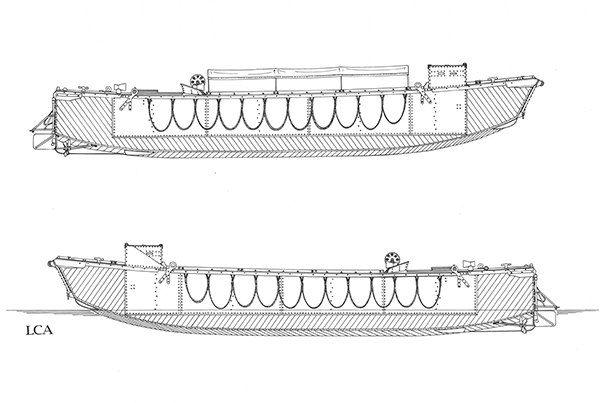
Paradigm-Creating Landing Barge: Even built of mahogany and—battle-loaded—displacing more than 9 tonnes, and proceeding at an excruciatingly sitting-duck 6 knots, these lca troop landing barges, designed and built for the British armed services, created world military history. What landing barges might have achieved, as per the original Fleming prototype—fabricated in aluminium and powered by twin 120-horsepower Chrysler engines—darting in through typically withering defending fire in a fraction of the time, can only be imagined. Aluminium was, of course, prioritised for aircraft construction. Thornycroft, by emulating Fleming’s design but dodging the need to compete for scarce skills and materials, won the work and delivered around 2000—built in disparate furniture factories and the like.
artist Hubert Cance
By any reasonable criteria, the
J Barry Ferguson can be described as a landing barge. Clearly not in the assault-troop-landing sense, not least of all because of its diminutive size. In one very important respect, however, the
J Barry Ferguson is not a typical landing barge, nor are landing barges typical barges, but
open boats—that is, vessels that are not
fully deckedthat is, vessels the hulls of which are not protected from entry of water, by means of complete decks or other superstructure.
Not that open boats—or, to use a more useful description, open vessels—are anything to be sneezed at, particularly when crewed by burly Vikings sailing to the farthest, North American, of extent of their voyaging, in their undeckedany decking deployed was as a working platform, and not watertight longships. While the J Barry Ferguson does indeed have a deck, depending upon how deeply she is loaded, and trimmed, her deck may be barely above water, or below it. Given the vessel’s otherwise good, high topsides, the barely-above-waterline deck means that any water atop it can’t always be relied upon to obediently drain away back into the sea. Water inside an open boat, as any person messing about in boats or canoes can attest, can be alarmingly destabilising. Similarly, were Vikings fool enough to leave their longship bilges unbailed for too long, they wouldn’t have made it far into the Baltic, much less the North Sea and beyond.
Curiously, somewhere between the regional park landing barge’s design and its service, a crucial detail was lost sight of: its open scuppers through the transom. Despite the design-approval letter specifying that the scuppers should be fitted with hydrostatic“or another means of clearing trapped water to the satisfaction of the surveyor” valves“or another means of clearing trapped water to the satisfaction of the surveyor”, they were never fitted with the requisite non-return devices. Perhaps if the design had called for positively closing bungs, which it almost certainly should have, the danger the open scuppers presented would have not been overlooked. But also omitted in the design or its approval was an accompanying means of removing any introduced water accumulating on the deck, when the deck was loaded or trimmed at or below the surrounding water level.
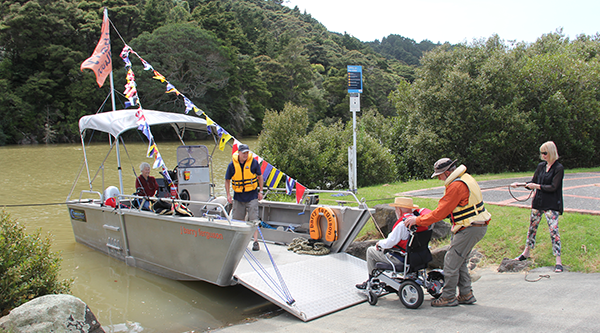
Beauty of Platform-Level Boarding: A key component of true btr—bus rapid transit—is possibly the J Barry Ferguson ’s best feature, that is the level boarding that is a boon to those dependent upon the likes of the powered wheelchair effortlessly whisking the vessel’s namesake aboard on the occasion of his 92nd birthday. It was also on that occasion that the first chinks in the craft’s design and build appeared, when it began to become apparent that the lovely, low, wide deck could quickly lead to catastrophic capsize, if mishap or miscalculation caused it to flood sufficiently for free-surface-effect took hold.
photographer Maree Owston-Doyle
Water atop a deck, unable to readily drain—or be pumped—overboard, produces probably the most notorious naval-architectural hazard, after the lack of load lines and watertight bulkheads: free surface effect. Free surface effect caused the two-year-old purpose-designed Cook Strait ferry tev Wahine to capsize in 1968, and too many Baltic, North Sea, and other roll-on-roll-off vessels before and since. The first glimpse of the J Barry Ferguson ’s vulnerability to free surface effect was on the occasion of its namesake’s 92nd birthday, Mahurangi River picnic excursion. With the propellers picking up a little mud, several of the six persons aboard moved closer to the bow. Immediately, water ran in under the closed bow ramp as though it was open, precisely reflecting the surrounding river-level. With all crew immediately back aft, the water drained out almost as quickly as it had flooded in. The proximate cause was the failure of the bow-ramp seal, which was known to be far from perfect. The surprise, however, was how deeply the vessel trimmed by the bow, when only half the proscribed maximum of six persons on board moved forward.
Inability to support much weight forward should not, on reflection, have been surprising—a significant portion of the vessel’s weight, including its massive bow ramp, is forward of the point where the immersed hull begins to gain volume. Subsequent, practical exploration of forward stability led to the, not entirely egregious exaggeration:
What we got here, is a barge balanced on top of a tinnyAotearoa/Australia vernacular for an aluminium open boat, and the barge bit’s got big open holes in the back!
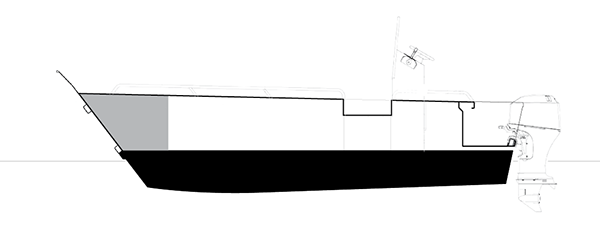
On It Not In It: Whereas the weight of troops carried aboard Britain’s militarily game-changing lca was concentrated below the waterline, the J Barry Ferguson carries all its people and equipment above, for convenience of loading and unloading. The inherent danger that the above-waterline deck introduces is that if even small volumes of water are to flood onto it, the craft is instantly subject to augmented free-surface-effect—the phenomenon that capsized the tev Wahine—on steroids. Following a series of such tragedies—infamously, in the Baltic and the North Sea—ferries were no longer designed with their vehicle decks running all the way out to their hull sides. Full-width buoyancy here is shaded black, supplementary buoyancy, at either bow quarter, grey, and waterline estimated with 6 persons on board.
drawing Mahurangi Magazine
Deliberately hyperbolic, sure, but only to the extent that the barge is open, and its bottom is welded watertight to said tinny. While barges are generally decked vessels, landing barges since the ubiquitous World War II lcas, are wellwell as in water well, not well as in healthy-decked vessels. The lca had its troop deck set as low in its wooden hull as practicable. At its forward end, the troop deck ramped up to watertight double-hung doors, then ramped up a little higher still, to the sill of the bow ramp. The troop deck was positioned low, for stability, rather than sat high, as in the J Barry Ferguson, so as to be self-draining.
Somewhere between formal design approval and its building, it appears that the J Barry Ferguson, began to be thought of as decked vessel—a conventional barge—rather than the open boat she fundamentally is. This was likely due to a number of influences, not least of all her little-ship persona—adored by all her happen upon her plucky profile, not least of all her marine surveyor. The fact that the non-return valves stipulated in the design approval were omitted speaks volumes. Also, the scuppers installed were only 36% of the size stipulated—although not necessarily a bad thing in itself, one might imagine when sinking by the stern.
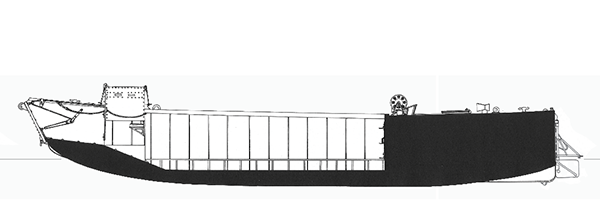
Open-and-Closed Case: This centreline section, contrasting the enclosed, buoyant areas of the lca—Landing Craft Assault—clearly shows how deeply within the barge the troop deck was built, unlike the J Barry Ferguson’s, see preceding image, perched much higher. The low, fore-and-aft bench seating ensured that the weight greatly added to stability of the landing craft—the troops sitting astride the longitudinal benches, allowing them to ‘ride’ the motion more comfortably, effectively moving their individual centres of gravity below the waterline, and keeping their leg muscles primed for the terrible charge ashore. It would appear that landing craft and roll-on-roll-off ships—vessels with decks vulnerable to free surface effect—don’t usefully sit under the regulations for open vessels or closed.
artist Hubert Cance
Charitably, it can only be surmised that the designer–builder believed that the craft’s deck had sufficient freeboard for the open scuppers aft to free the deck of any water that might find itself on board—many craft are designed that way, including most modern sailing dinghies. However, designed to weigh 900 kilograms, the very robustly built vessel weighs in at about 1.4 tonnes, appreciably reducing the deck’s freeboard. Collective decisions—between design, design approval, and build—mean that the J Barry Ferguson is currently not safe for carrying anything like the number of people she otherwise has the inherent capacity to have aboard. Heeling tests carried out by Mahurangi Action Incorporated on 12 June produced angle of heel of only 10.9° with the equivalent of 14 persons on board. Regulations currently permit a maximum heel-angle for open vessels of 15°—although likely reducing, possibly to 12°. What now needs to be addressed, before the craft is used in earnest to trial the Mahurangi Coastal Path, are the details variously neglected during the design, design approval, build, and survey:
- transom scuppers made definitively stoppable
- bow door made watertight and lockable—with the likes of redundant, over-centre levers
- free surface effect mitigated—buoyant bulwarksextension of a vessel’s side above the level of a weather deck. Bottom line here is the J Barry Ferguson, augmented by built-in bench seats
- means of instantly handling deck-water then promptly pumping it overboard—automatically deploying the instant deck-water is introduced.
Free-surface-effect mitigation should be the first issue addressed. The troop deck of a World War II landing barge was about 300-millimetres below its waterline, where the weight carried added to the craft’s stability. The deck of the ex-regional parks barge, presumably for simplicity, and ease of loading and unloading the likes of contractor’s ride-on mowers, is just above its waterline, where the weight carried has an inherent destabilising, rather than stabilising, effect. Additionally, scaling down a craft—in and of itself—generally results in a less stable vessel. The Royal Navy’s innovative lcas were more than twice as long as the J Barry Ferguson, and half as wide again, and weighedor more correctly, displaced, in battle mode, in wood and steel, nine tonnes—ten times more that the putative displacement of the aluminium barge.
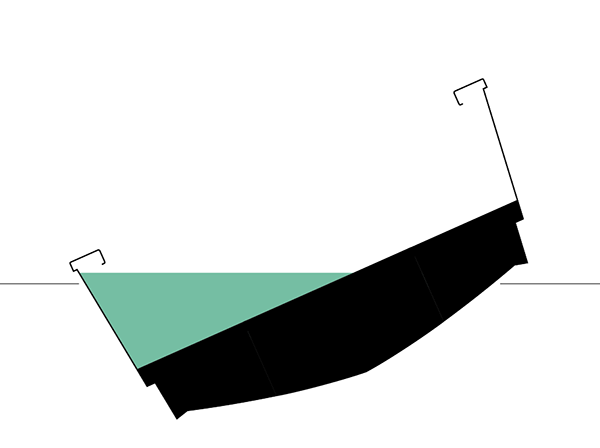
Free-Surface-Effect no Picnic: Excessive amounts of water in the bilge of a boat is no picnic, but atop a deck, if it is not free to instantly drain overboard, it is potentially catastrophically destabilising. The term free-surface is somewhat esoteric, referring to surface of the liquid, rather than the surface of the deck. In this example, it effectively refers to the fact that water on the deck is unrestrained, until it reaches the vessel’s bulwarksextension of a vessel’s side above the level of a weather deck. Bottom line here is the J Barry Ferguson, as built, would offer very little protection to those aboard, should it swamp—only after it went bottom up, would it likely begin to be safe to be in the vicinity of.
drawing Mahurangi Magazine
In the interests of completeness, it behoves the J Barry Ferguson ’s new owners to re-evaluate the design and consider what modifications might be made, then decide whether it has found itself in a you-can’t-get-there-from-here situation, and if so, sell off the vessel to a different purpose. Without prejudging the outcome, despite its serious shortcomings—some of which are inherent—the vessel also has many desirable attributes. For example, from the likes of a boat ramp, the level-deck-and-lowered-ramp combination, in conjunction with a powered wheelchair, is an accessibility triumph. Always obvious to students of naval architecture, however, was that the craft is decidedly short for its beam and scantlings—the size and strength of its, arguably overly-heavy, structural elements. Often, the biggest retrospective substantive improvement that can be made to a vessel is for it to be cut in two and a section added to its middle. This is particularly true of barge forms, where the middle section is straight. In the case of the J Barry Ferguson, the hull transitions from a truncated, moderate, v-bottom forward, to a shallow v aft—a classic shallow-v planning hull. However, were the transom and outboard well to be severed from the hull and moved two metres aft, the vessel would instantly gain tremendous fore-and-aft stability, and appreciable lateral stability, through sitting higher in the water. The vessel would also motor, loaded, at displacement speedslower than planning speed, where, rather than skating along essentially on top of the water, the vessel pushes through the water, displacing it as it does so, significantly more economically—particularly by transitioning from the flat planes of the planing hull aft into a modest rockeraft rocker: curve of the bottom upwards towards the waterline, better suited to the 5-knot speed constraint for vessels operating nearMaritime New Zealand: vessels must not exceed a speed of 5 knots (a fast walking speed) if they are within 200m of the shore theMaritime New Zealand: vessels must not exceed a speed of 5 knots (a fast walking speed) if they are within 200m of the shore shorelineMaritime New Zealand: vessels must not exceed a speed of 5 knots (a fast walking speed) if they are within 200m of the shore. And, as with the Auckland Harbour Bridge famously overbuilt and undersizedby one lane and two footpaths, when built in 1955–59, before four vehicle lanes were “clipped on”, in 1969, the nuggety core of the vessel would deliver its payday.
Unfortunately, while an 8-metre-long J Barry Ferguson would be better in almost every regard, nor would it magic away the dread, free-surface-effect threat. Open barges in particular, should long-since have ceased being built with single-skin hull sides adjacent a deck, where water atop that deck can surge all the way out the widest extent of a vessel’s beam. And given that the J Barry Ferguson, in order to be certificated to carry more than the current maximum of six, will be required to have built-in seating, it would be negligent in the extreme to add that seating whilst not also arranging it so as to provide that which should have been mandatory in such craft: buoyant bulwarks. Meanwhile, only by exploring the option of remedying the vessel’s principal shortcoming—its almost comical 2.3 beam-to-length ratioas measured at the waterline—will Mahurangi Action know whether it risks spoiling a potentially well-found ship for the proverbial ha’p’orthhalfpennyworth of tar.
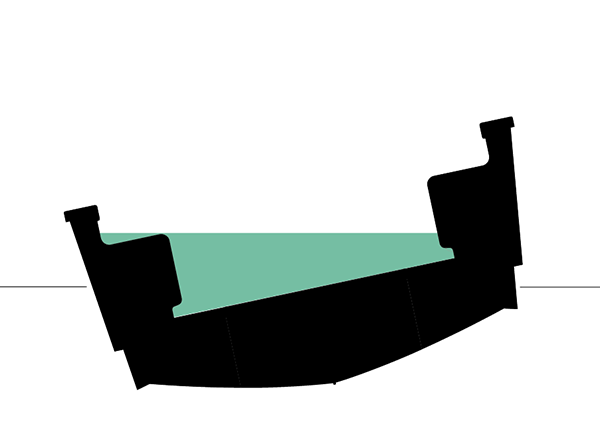
Sealed Fate: While buoyant bulwarks would go a long way towards mitigating free surface effect, a bow-ramp failure or green-sea swamping could swiftly see the J Barry Ferguson at, or beyond, the point of capsize. In this scenario, it is the buoyancy in the wrong place—under the sealed deck—that is the culprit. The 12° angle of heel displayed here indicative only.
depiction Mahurangi Magazine
In addition to costing the remedial measures—both lengthened and non-lengthened—a suite of safety modifications that includes a comprehensively locking bow ramp, positively closing scuppers and means of clearing water from atop the deck, will be costed. Should the funds not be immediately forthcoming to have the craft majorly modified, it might still be useful to have the craft in service, under its current survey, but with the essential modifications made, and an abundance of caution practiced during its operation.
In fairness to those responsible for the craft prior to its purchase for Mahurangi Coastal Path use, it had been designed, built, certificated as a workboat, not a ferry. Had Mahurangi Action immediately pressed the vessel into service trialling the coastal path—as it was intent on doing—ferrying members across the Pūhoi Estuary, it might have injured someone or worse. Morally, it would have been guilty of “exposing individuals to risk and harm” for having failed to independently review the vessel’s suitability for landing people rather than equipment. It’s an ill wind that blows buggers no good, and the organisation is grateful that the numerous delays caused by the weather—particularly, the atmospheric river that cancelled the Mahurangi Regatta —intervened long enough for the pennies to begin to drop.
The road to redemption, it embarrasses Mahurangi Action to admit, did not begin, as it might have to actors of less limited wit, with a single, eureka moment, when water flooding onto the forward end of the deck first began to draw attention to core, problematic buoyancy characteristics. To cut to the climax of the long, drawn-out process, the recent rediscovery of a key structural element bequeathed to the vessel by its initial designer, finally led its current owners out of the woods-for-the-trees thicket they’d found themselves in.
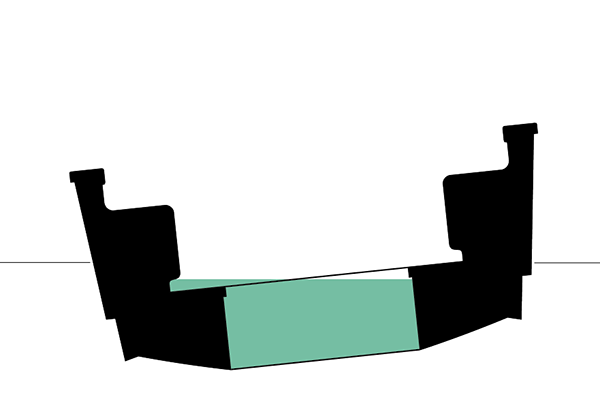
Six Degrees of Separation: With capacity for about 2.5 tonnes of deck-water in the central bilge, the deck would be almost instantaneously freed following a major bow-ramp-flooding or green-sea event that could otherwise result in a free-surface-effect catastrophe. Even with 1.8-tonne of persons22 x 80-kg allowance for persons and effects-in-wrong-place, it is unlikely that the 6° angle of heel depicted here would be exceeded.
design Mahurangi Magazine
Two girders had been detailed, where the first stringers inboard of the hull sides would normally be found. They were included to compensate for the wheel-mount ports that, in effect, took a substantial chunk out of each hull side, from gunnel to the deck. Earlier, Mahurangi Action elected to abandon the initial design’s semi-amphibious attribute—beach wheels too small and supporting structure insufficiently robust, and semi-amphibious capability not key to the proposed operation. Rather than weld up the redundant, eye-wateringly expensively created ports, the new owner saw enormous utility in providing level access, through the high topsides—from the Pūhoi Jetty, and pontoon docks elsewhere. The girders, briefly, suggested an almost ready-made means of laterally delineating the buoyancy essential to ensuring residual, swamped-vessel stability. Close, but no cigar, but by installing a second pair of girders inboard—rather than lift and reuse the stringers currently serving there—buoyancy is added where it is required, where it will augment the crucial buoyant-bulwarks.
Buoyant bulwarks, it has relatively recently been convincingly argued, are the key landing-craft component. Even the original, lca had cork buoyancy arranged along the insides of its bulwarks. The master’s research in mechanical engineering thesis Stability Requirements of Naval Landing Craft (Hayes, 2014) is said to be the best study to date on landing-craft stability. Unsurprisingly, it highlights the imperative for buoyant bulwarks:
For example, what would happen were the bulwarks only plate, with no buoyant volume …as
shown in Figure 8.5 (in the study, as compared to Figure 8.4)? The situation is drastically worse.
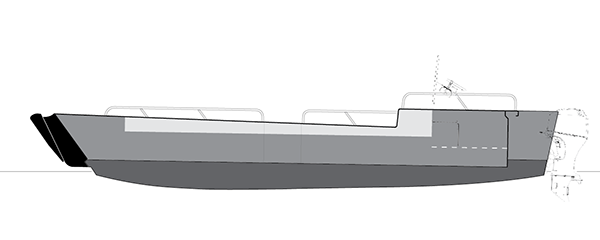
Longer Boats: Addressing the three fundamental shortcomings of the J Barry Ferguson will not come cheap, which obliges the owner, Mahurangi Action Incorporated, to consider simultaneously addressing what could be considered an inherent, crippling attribute—its all-bow-and-no-boat proportions. The design issue with the vessel’s shortness is that it lacks the buoyancy forward needed to safely support the bow when the bow ramp is lowered, and weight—in the form of persons or property—is loaded or unloaded via that ramp. Depicted here is the buoyancy profile the J Barry Ferguson might assume if lengthened 2.1 metres. So lengthened, and with its other identified deficiencies addressed, she might potentially safely operate with 22–23 persons on board, whereas currently, she is probably unsafe with more than two or three, depending upon the activity, wind and sea state. Buoyancy here is shaded commensurate with the lateral depth of buoyancy chamber. Also buoyant, in this proposal, is the bow ramp, which, additionally, is articulated—increasing its reach while, with the addition of the quarterdeck indicated, markedly improving visibility from the helm. Waterline here, with 22 persons on board, indicative only.
design Mahurangi Magazine
The rediscovered girders, however, had provided the germ of an idea of how, by addressing the bottom-line need for unequivocally buoyant bulwarks, the vessel’s other enemy of stability, the sealed-buoyancy situated in the worst-possible place, could simultaneously be addressed. Sealed buoyancy is currently concentrated in the lateral centre of the craft, in its v-bottomed hull—under its readily floodablearguably, all-too-foreseeably floodable deck, it is a capsize waiting to happen. The v-bottom also increases the draft, making accessing locations such as Lagoon Bay even more highly tide-dependent. Installing the aforementioned new girders simultaneously allows the 1-metre-wide middle section of the v-ed bottom, to be replaced with a flat bottomflat athwartships; rockered (curved) fore-and-aft, resulting in a sophisticated, easily driven, shallow-draft hull form—the best features of the original build retained; the worst eradicated.
Having identified a wholesome, comprehensive remedy, Mahurangi Action must now do the hard, quantity-surveying yards, and, with more than a little help from its friends, identify a cost-effective route to effecting the improvements needed. If a viable route can be identified, and likewise the accompanying, commensurate fundraising route, then the process of design and design approval would begin. This deserves to happen sooner rather than later. With the developing El Niño promising, sooner or later, to end the procession of sub-tropical lows, the sooner the J Barry Ferguson is in a fit state to begin introducing members to the magnificence of walking the Mahurangi Coastal Path, the better. Potentially, the organisation is poised to redeem the risk it came so close to taking, robustly repurposing the vessel—built to serve the regional parks—doing it proud, as the J Barry Ferguson, ensuring she reaches her full potential, linking the Mahurangi regional parkland, Waiwera to Martins Bay, as one, glorious 1000-hectare regional park.
Purpose-designed flat-bottomed footnote Work-to-date estimating the probable cost of extending the J Barry Ferguson to 8 metres is tending to confirm the intuition that it could cost as much again as the purchase price. For some time, one member of the team was already of the we-can’t-get-there-from-here persuasion. Recently, another admitted that he was of increasingly of that view. Consequently, this writer has revisited, pictured below, the pre-Park Ranger concept published in May 2019, and is rapidly forming the opinion that it would be a far better use of resources.
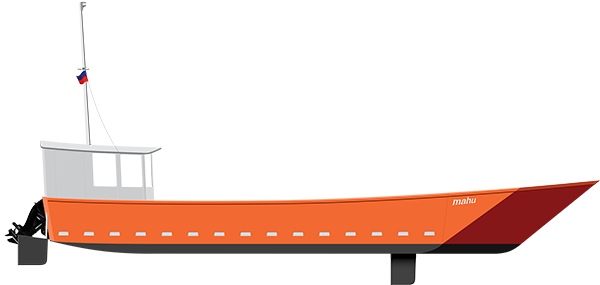
Full Circle: Having instantly won hearts and minds, the design for a purpose-built scow, provisionally named the Mahu, was set aside when what seemed to be a ready-made, built-to-survey vessel became surplus to regional park operations. Now, serious consideration is being given to the above design being realised, as a purpose-built J Barry Ferguson.
design Mahurangi Magazine
The main design compromise that comes with any conversion of the Park Ranger is its greater-than-ultra-shallow draft, and its sticky bottom. For the Mahurangi Coastal Path to be a Mahurangi Coastal Path, it needs to cross the Mahurangi Harbour. That means embarkation/disembarkationsurely we should have a less cumbersome word—’mbarkation?—for embarking and alighting a vessel or vehicle? in the famously shoal Lagoon Bay, on the remote Mahurangi Peninsula. For most craft, embarkation on a falling tide is impracticable—the combination of extra weight aboard, and less water in which to float. Unsurprisingly, this is not an insurmountable challenge for oyster farmers. Barges with flat bottoms uncompromised by runnersbottom runners, longitudinal strakes to provide directional stability and/or to protect the hull from wear when grounding can be refloated after inadvertent partial—or calculated—groundings with alacrity, while harvesting oysters. With a bit of skill and muscle, some can even be slid back into the tide after being fully stranded, fully loaded.
The key attributes, for a barge to be stranding-resistant, are threefold. The bottom must be predominantly flat, to spread the weight over as much mudflat as possible. There must be no protrusions such as keelsons, runners, or rivets. The bottom surface must be of a hard and non-binding material—unlike aluminium, regarding the latter attribute—and preferably self-lubricating. As luck would have it, such a surface exists and can readily be applied to plywood, in the form of epoxy-graphite. And a good amount of plywood is already to hand, purchased to build a shelter for the corrosion-prone aluminium Park Ranger .
A purpose-built J Barry Ferguson would also have a rather different bow-ramp configuration. Designed for the embarkation/disembarkation of people, with or without wheelchairs—as opposed to vehiclesmowers, in particular—and where there may be stiff current flowing, bow ramps, plural, are deployed, which allow the craft to be angled to the shore with the shoreward ramp deployed. The raised ramps, meantime, provide a pointy end, rather than a square one. This—New Zealand scow type, but pointier—allows the craft to steam head on into large seas, safely parting their impact—something that square-bow barges are brutes at doing. Although the largest waves the purpose-built scow would be designed to encounter would be swell-against-tide when exiting the Pūhoi Rivermouth, there would also be many occasions crossing the Mahurangi Harbour where having a sharp scow bow would hugely improve the comfort of those aboard—those who famously feel sick, at the mere sight of a travel poster.
Importantly, the design of the purpose-built J Barry Ferguson would incorporate the learnings from the Park Ranger experience. Rather than the liberally self-draining deck of the 2019 Mahu design, above, the deck would be set low, à la lca, and its outer edges brought well inboard by built-in seating—to mitigate free-surface-effect. The benches, forming part of liberally buoyant bulwarks, would guarantee great swamped-vessel stability. The net result, in respect to the lower, built-in seating, would be more stability, and less exposure of those seated to windchill. Although the seats would be richly upholstered, to make it abundantly clear they were not to be stood on, the bulwarks would be topped with wire guardrails set so as to discourage sitting atop the otherwise-all-too-appealing bulwarks.
Another feature that the purpose-built J Barry Ferguson would incorporate, from the extant J Barry Ferguson, would be the side-boarding ports created more recently in to enable rapid, level embarkation/disembarkation from floating docks such as at the Wenderholm Jetty. These would also tick, very decisively, the possibly soon-to-be-regulatory requirement that an unresponsive person be readily recovered from the water.
Myriad other benefits arise from the purpose-design-and-build approach, not least of all a toilet. Although not required by maritime authorities for short voyages, in the Mahurangi Coastal Path setting, the person embarking may have already been deprived of a toileting opportunity for some time—not to mention the patient volunteer crew, who will also benefit from more protection from the elements than a mere bimini. Scale, though, is important. The purpose-built J Barry Ferguson would be 12 metres by 3.6 on deck—about two and a half times the sum of those dimensions of the extant craft. This means that the weight of half a dozen—or even a dozen—persons-in-the-wrong-place is not nearly as problematic.
Inherently, and unavoidably, a purpose-built J Barry Ferguson would be a prototype—a vessel on which to make mistakes and iron out defects. But if it performs as well as it might, during heeling tests and swamped-stability tests, it could lead to a small fleet of such craft being built. A sailing scow along such lines would be make a marvellous, affordable, latter-day mullet boat—one that could be owned, or hired, by a group of young people, with the deck and bench-seat space needed for summer nights slept under boom tents.
Open-boat speaks volumes That the current regulations use the term open boat to differentiate between craft such as the J Barry Ferguson and most decked vessels, speaks volumes. It reflects the fact that, aside from the likes of specialist open vessels such as hopper barges, if a vessel is undecked, the chances are it will be of a size that most people would immediately think boat rather than vessel or ship. Boats, however, can be big. Steamboats, such as those that serviced the Mahurangi until the 1930s, can be the size of small ships, and they were very definitely decked. Somewhat more helpfully, it is likely that new regulations will refer to vessels without—or with marginally above-waterline—decks as open vessels, rather than open boats.
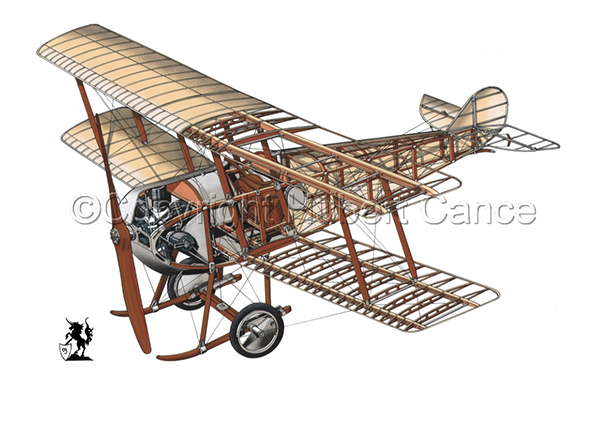
Pornography for a Prepubescent: Only after discovering Hubert Cance’s contribution to maritime military history, did the author get to glimpse Cance’s body of work richly encapsulating the author’s childhood fascination with cutaway sections and Sopwith fighter planes!
artist Hubert Cance
Stealth barge In what might have been a historic case of fools and bairns should never see half‐done work, Fleming demonstrated his design for a stealth landing barge to the authorities in a refined, highly functional form, in all respects other than its need to be silent. The roar of its unsilenced twin 160-horsepower Chrysler v8s, reverberating in its empty-vessel aluminium hull, stampeded beach-visiting mothers to scoop up their bairns and flee the invasion-threatened coast. A further mark against Fleming’s courageous favouring of aluminium and speed—which potentially would have greatly enhanced the vessel’s element of surprise, was the difficulty of attaching the hardened-steel protection against small-arms fire that was part of the brief. Be that as it may, all but naval architect Fleming’s surname, appears to have been lost to history. It is to be hoped that he—and those at Fort CumberlandHome of the 1938 – 1942 Inter-Service Training and Development Centre who perceived, post-Gallipoli, the urgent imperative for new type of craft from which to invade or reclaim territory—died with satisfied minds.
French lca admirer Given the hundreds of sets of blueprints that must once have been in the hands of the cabinetmakers and others tasked with building Britain’s revolutionary Landing Craft Assault, it is ironic that none appear to have survived. Fortunately for posterity, their elegantly functional form—ignoring the awkward, forward-control helmstation—has been nicely recorded by artist Hubert Cance:
Yes, the lca was very well conceived. In some ways, I think that the propellers look better protected than those of the us equivalent, the lcvp, especially for beach landing, but I am not a sailor, living in the mountains of the French central highlands. Your project looks very interesting.
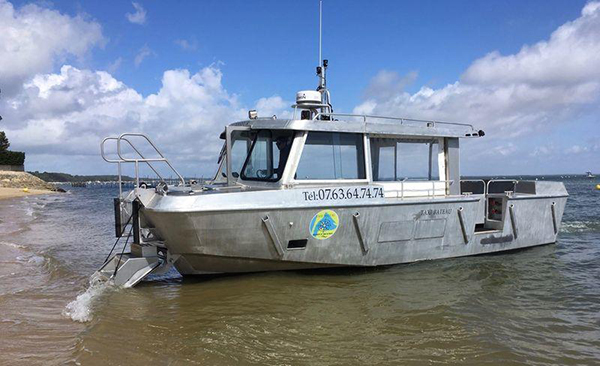
Uncanny Connection: While most of the Arcachon Bay oyster barges would not look out of place in the Mahurangi, the older craft, and oyster-tour craft, are bateau of more elegant configuration. Then, bizarrely, there is this Arcachon water taxi that shares three far-from-common features sported by the J Barry Ferguson : front and side loading. A major, core difference, is that the water taxi is not designed as an open vessel, featuring large open scuppers forward, and side boarding openings themselves, are designed to serve as scuppers. Potentially though, in the accessibility stakes, with the ‘new’ J Barry Ferguson, the Mahurangi Harbour will have it all over le Bassin d'Arcachon.
image
arcachon.com
French oyster connection Possibly piqued by the author’s oyster-barging background, French artist Hubert Cance, when generously agreeing to allow the reproduction of his lca depictions, mentioned:
I spent a few summer holidays near Arcachon Bay in France where there are many oyster farms and remember well their ‘flats’ vessels.
Bassin d'Arcachon, it embarrasses this Mahurangi foreignerTe Kūiti-born, so only putative greater-Mahurangi resident for 64 of 76 years to admit having not known, is the international home of oyster aquaculture, dating from 1859. Arcachon’s rocky 164-year aquaculture history shares many junctures experienced in the Mahurangi, in its half-century, not least of all the entire species replacement of the farmed stock following the accidental introduction of Crassostrea—gigas, in Mahurangi, thanksapocryphally, at least, it is believed the foreign oysters rode in on slow, sea-barge journey from Japan to the earlier-alluded-to sea-barged Auckland Harbour Bridge clip-ons; and angulata, in Bassin d'Arcachon, appearing following the 1868 sinking of a Portuguese ship off Gironde, the next major estuary north. Arcachon, much later, went with gigas, at about the same time as they began appearing in the Mahurangi. Except, that while Crassostrea angulate, is Crassostrea angulate, what was known as Crassostrea gigas in Aotearoa and Japan, it transpires, is the closely related species Magallana gigas.
Believing in electric ferries Due to the too-infrequently-challenged ideology that everything that can be battery-powered should be battery powered, the fossil-fuelled engines of the J Barry Ferguson will invariably come in for scrutiny. There is absolutely no doubt that electrification, at scale and pace, must form a major part of carbon-emissions curtailment. Unfortunately, all too few writers risk alienating readers who fervently want to believe that global decarbonation can be achieved within a decade or two—especially now that there is widespread agreement that civilisation is, increasingly, experiencing unprecedented disruption. Writer and energy polymath Vaclav Smil has spent the better part of his working life attempting to explain How the World Really Works : The Science Behind How We Got Here and Where We’re Going, with little apparent impact on policy makers.
Locally, the dearth of robust public discussion around the most important energy decision in Aotearoa since Tiwai Point—Lake Onslow pumped hydro storage—has so exercised New Zealand’s Parliamentary Commissioner for the Environment that he commissioned modelling to determine the economics of four future electricity pathways for the country. If Commissioner Simon Upton is successful, New Zealanders will learn to what degree generators addicted to precipitating high spot prices would condemn an ever-greater percentage to future energy poverty. Whether this and future governments do their job and ensure that the systemic upheaval resulting from eliminating fossil fuel emissions from New Zealand’s economy is both effectual and equitable is far from certain.
What can be guaranteed is that the fossil-fuel-emissions-mitigation challenge is immense, and key to rising to that challenge is to rapidly become astringently strategic about the requisite electrification process. That which replaces the greatest amount of fossil fuels with the least amount of battery power is the urgent imperative. For example, if the electrification of public transport, using in-motion-charging trolleybuses is soon seen on Auckland’s busways, beginning the rapid retirement of the bulk of its fleet of 1000 diesel-powered buses, there is hope. If instead, the Hauraki Gulf first hosts a fleet of 100% battery powered-ferries, chances are it is game over for a survivable climate—political vanity project versus how the world really needs to work. And while a short-run electric ferry might stack up, such as at the Pūhoi Rivermouth, there is little doubt that a footbridge—much farther upstream—would be a far, far better use of the funding.
Disclosure The author of this article is the secretary of both Mahurangi Action Incorporated and the Mahurangi Coastal Path Trust, and has voted Māori, more than once. The article published here, however, is that of the editorially independent, independently funded Mahurangi Magazine.
 1 2 3 fix mmp
About, about…
Annual report
chart competition
Climate-action mobilisation
hmss Buffalo
Jade River: A History of the Mahurangi
Mahurangi Action Inc.
Mahurangi Action Plan
Mahurangi Coastal Path
Mahurangi Gallery
Mahurangi Magazine
Mahurangi Regatta
Open-ground indigenous plants establishment trials
Regional parkland
Watermills, millraces, dams and weirs
1 2 3 fix mmp
About, about…
Annual report
chart competition
Climate-action mobilisation
hmss Buffalo
Jade River: A History of the Mahurangi
Mahurangi Action Inc.
Mahurangi Action Plan
Mahurangi Coastal Path
Mahurangi Gallery
Mahurangi Magazine
Mahurangi Regatta
Open-ground indigenous plants establishment trials
Regional parkland
Watermills, millraces, dams and weirs










